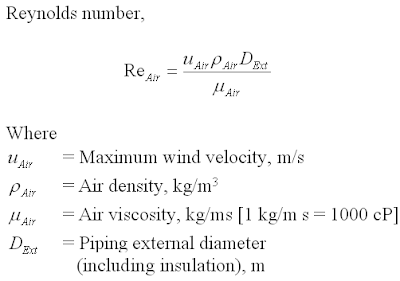Wednesday, September 29, 2010
Earlier post "How Boil-Off-Gas (BOG) is Generated" and "Quick Way to Estimate BOG" discussed several ways result Boil-Off-Gas (BOG) generation and simple way to estimate BOG. Heat leak into piping wrapped with Cold insulation is one of the way possibly result significant BOG generation, in particular in large base load plant where product is loaded into ship. Long rundown and loading line from production plant and from storage tank to ship can generate significant BOG. Proper selection and determination of insulation thickness can minimize BOG generation economically.
Overall heat transfer cooefficient estimate from Nusselt number :
Piping in-leak heat can be estimated with following equation
with heat flux
Piping external diameter = 152.4 mm
Piping length = 100 m
Insulation material = Polyisocyanurate
Insulation thermal conductivity = 0.023 W/mK
Assumed Insulation thickness = 60 mm
Piping external diameter (including insulation) = 152.4 + 2x60 = 272.4mm
Air :
Air Velocity = 5 m/s
Air Thermal Conductivity = 0.029 W/mK
Air specific heat = 1009 J/kgK
Air density = 1.038 kg/m3
Air viscosity = 0.02 cP
Calculation :
Air Prandtle Number = 0.6959
Air Reynolds Number =70687.8
Overall Heat transfer Coefficienct = 18.096 W/m2K
Piping In-leak heat = 2125.72 W
Piping surface area = 85.58 m2
Average heat flux = 24.8 W/mK < 25 W/mK...OK
Similar calculation applied to 1" to 28"
1" - 50mm insulation thickness
2" - 50mm insulation thickness
3" - 60mm insulation thickness
4" - 60mm insulation thickness
6" - 60mm insulation thickness
8" - 70mm insulation thickness
10" - 70mm insulation thickness
12" - 70mm insulation thickness
16" - 70mm insulation thickness
20" - 70mm insulation thickness
24" - 70mm insulation thickness
28" - 70mm insulation thickness
Key Rule
Rule of thumb for economic heat flux for heat in-leaks range from 25 to 35 W/m2. This is the key rule to derive an economic insulation for cold service whilst minimizing BOG generation.Recommended :
- Subscribes to FREE Hydrocarbon Processing
- Tips on Succession in FREE Subscription
 Insulation Material & Thermal Conductivity
Insulation Material & Thermal Conductivity
Common insulation material used in cold services (sometime called cryogenic service in extremely low temperature case e.g. LNG with operating temperature of approximately -162 degC) are typically Polyurethane and Polyisocyanurate Foam (PIR). These insulation material have very low conductivity minimizing heat from ambient entering cold fluid. Typical thermal conductivity for these material is approximately 0.023 W/mK @ 20 degC.- Subscribes to FREE Hydrocarbon Processing
- Tips on Succession in FREE Subscription
Insulated Piping In-Leak Heat
Estimation of piping in-leak heat from ambient starts with estimation of heat transfer coefficient using Nusselt number which is a function of Prandtle and Reynolds number.Overall heat transfer cooefficient estimate from Nusselt number :
where Prandtle number
and Reynolds number
Piping in-leak heat can be estimated with following equation
with heat flux
Case study
Piping nominal size = 6"Piping external diameter = 152.4 mm
Piping length = 100 m
Insulation material = Polyisocyanurate
Insulation thermal conductivity = 0.023 W/mK
Assumed Insulation thickness = 60 mm
Piping external diameter (including insulation) = 152.4 + 2x60 = 272.4mm
Air :
Air Velocity = 5 m/s
Air Thermal Conductivity = 0.029 W/mK
Air specific heat = 1009 J/kgK
Air density = 1.038 kg/m3
Air viscosity = 0.02 cP
Calculation :
Air Prandtle Number = 0.6959
Air Reynolds Number =70687.8
Overall Heat transfer Coefficienct = 18.096 W/m2K
Piping In-leak heat = 2125.72 W
Piping surface area = 85.58 m2
Average heat flux = 24.8 W/mK < 25 W/mK...OK
Similar calculation applied to 1" to 28"
1" - 50mm insulation thickness
2" - 50mm insulation thickness
3" - 60mm insulation thickness
4" - 60mm insulation thickness
6" - 60mm insulation thickness
8" - 70mm insulation thickness
10" - 70mm insulation thickness
12" - 70mm insulation thickness
16" - 70mm insulation thickness
20" - 70mm insulation thickness
24" - 70mm insulation thickness
28" - 70mm insulation thickness
Labels: gas processing, LNG





1 Comments:
superb post here, uh!
Post a Comment
Let us know your opinion !!! You can use some HTML tags, such as <b>, <i>, <a>
Subscribe to Post Comments [Atom]
Home:
<< Home